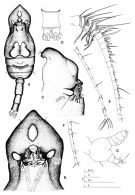|
|
 |
|
Calanoida ( Order ) |
|
|
|
Clausocalanoidea ( Superfamily ) |
|
|
|
Aetideidae ( Family ) |
|
|
|
Pterochirella ( Genus ) |
|
|
| |
Pterochirella tuerkayi Schulz, 1990 (M) | |
| | | | | | | Ref.: | | | Schulz, 1990 (p.182, Descr.M, figs.M); Markhaseva, 1996 (p.296, figs.M) |  issued from : K. Schulz in Mitt. hamb. zool. Mus. Inst., 1990, 87. [p.183, Fig.1]. Male (from Indian: G. of Aden): habitus (lateral left side). Bar: 0.5 mm. Nota: Prosome/Urosome length ratio = 2/1. Head and 1st pediger somite fused, 4th and 5th fused (short line of demarcation showing dorsally).
|
 issued from : K. Schulz in Mitt. hamb. zool. Mus. Inst., 1990, 87. [p.184, Fig.2]. Male: A, habitus (dorsal); B, cephalosome (dorsal); C, idem (lateral left side); D, caudal rami (ventral); E, left A1; F, right A1 (segments 19 to 22; G, Md. Nota: Rostrum absent, but 2 small filaments. - Anterior part of cephalosome with dorsal hump and, in region of Md region, sudden transversal cleft, accompanied by bilateral-symmetrical processes (lobe-like structures usually reinforced inside by cone-shaped chitinous process; tips of these structures appear to be broken). - Dorsal body wall of 1st pedigerous somite equipped with bilateral-symmetrical prominence producing bulbous swelling on either side of midline, both equipped anteriorly with small fingered appendix. In lateral view bulbous swelling transparent. - 2nd pediger somite dorso-distally furnished with row of strong bristles, and 2 long spinules anterodorsal of row of bristles. - Genital aperture located on left side of 1st urosomal somite. - Anal somite very short (almost completely telescoped into prceding one. - Caudal rami bearing 1 short outer seta and 4 setae terminally (2nd to innermost seta longest, about 2.0 mm), small appendicular seta arising from ventral surface. - Md without mandibular blade, exopod longer than endopod. - A1 with incomplete fusion of segments 9-10 and 12-13, and complete fusion of segments 24-25; segments 20-21 are fused on the right but separate on the left.
|
 issued from : K. Schulz in Mitt. hamb. zool. Mus. Inst., 1990, 87. [p.185, Fig.3]. Male: A, A2; B, Mx1; C, Mx2; D, Mxp; E, P1 (anterior); F, P1 (endopod and exopodal segments 1 and 2); G, P2 (posterior); H, P3 (posterior); I, P4 (posterior); J, P5 (anterior); K, P5 (left exopod, distal part). Nota: Mx1 with inner lobes greatly reduced; basis and endopod with 2 and 10 setae, respectively; exopod with 11 setae; outer lobe well-developed with 7 setae. Mx2 greatly reduced in size and setation, proximal lobe 1 without seta, lobes 2 to 6 with 1, 2, 2, 2, 1 setae, respectively; endopod with ca 3 setae. Right exopod of P5 very long, extending as far as caudal ramus
|
 issued from : K. Schulz in Mitt. hamb. zool. Mus. Inst., 1990, 87. [p.183, Table 1]. Table 1: Armature of left A1, right (rt): right one below.
| | | | | Compl. Ref.: | | | Bradford-Grieve, 2004 (p.284) | | | | NZ: | 1 | | |
|
Distribution map of Pterochirella tuerkayi by geographical zones
|
| | | | | | | Loc: | | | NW Indian (Gulf of Aden)
Type locality: 12°30,7'N, 45°41,6'E. | | | | N: | 1 | | | | Lg.: | | | (266) M: 3,28; {M: 3,28} | | | | Rem.: | hyperbenthic. (1318 m); probably near-bottom habitat at batyal depths. In a baited trap.
Schulz (1990, p.186, 188) points out this species appears unique among calanoid copepods in the transformed dorsal cephalic integument. The peculiar dorsal cephalic cleft gives rise to speculations on its possible function. However, it appears that such individual may occasionally attach itself by a firm squeeze to whatever type of substrate, organic or inorganic, that projects beyond a given surface (interpretation supported by the presence of a pair of dorsal longitudinal muscles inserting near the posterior rim of the cephalic cleft and stretching posteriad. An "associated" mode of life in attachment to an unknown animal host should be a possibility. | | | Last update : 25/03/2016 | |
|
|
 Any use of this site for a publication will be mentioned with the following reference : Any use of this site for a publication will be mentioned with the following reference :
Razouls C., Desreumaux N., Kouwenberg J. and de Bovée F., 2005-2025. - Biodiversity of Marine Planktonic Copepods (morphology, geographical distribution and biological data). Sorbonne University, CNRS. Available at http://copepodes.obs-banyuls.fr/en [Accessed August 23, 2025] © copyright 2005-2025 Sorbonne University, CNRS
|
|
 |
 |






